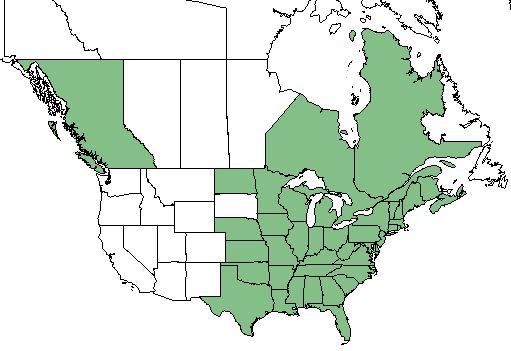Difference between revisions of "Prunus serotina"
(→Ecology) |
|||
| Line 34: | Line 34: | ||
''P. serotina'' proliferates in rich coves, bottomlands, northern hardwood forests, and in a wide variety of lower elevation habitats from dry to mesic, and weedy in fencerows. <ref name= "Weakley 2015"> </ref> | ''P. serotina'' proliferates in rich coves, bottomlands, northern hardwood forests, and in a wide variety of lower elevation habitats from dry to mesic, and weedy in fencerows. <ref name= "Weakley 2015"> </ref> | ||
===Phenology=== <!--Timing off flowering, fruiting, seed dispersal, and environmental triggers. Cite PanFlora website if appropriate: http://www.gilnelson.com/PanFlora/ --> | ===Phenology=== <!--Timing off flowering, fruiting, seed dispersal, and environmental triggers. Cite PanFlora website if appropriate: http://www.gilnelson.com/PanFlora/ --> | ||
| − | ''P. serotina'' flowers February-April. <ref name= "PanFlora"> PanFlora Author: Gil Nelson URL: [http://www.gilnelson.com/PanFlora/ http://www.gilnelson.com/PanFlora/] Date Accessed: 5/24/18 </ref> | + | ''P. serotina'' flowers February-April. <ref name= "PanFlora"> PanFlora Author: Gil Nelson URL: [http://www.gilnelson.com/PanFlora/ http://www.gilnelson.com/PanFlora/] Date Accessed: 5/24/18 </ref> This tree sometimes reaches a height of 90 feet and a maximum trunk diameter of 4 feet. The trunk is straight and covered with rough black bark, but the young branches are smooth and reddish. The smooth shining leaves are about 2 to 5 inches long. The long drooping clusters of small white flowers are borne at the ends of the branches, usually during May. The cherries, which ripen about August or September, are round, black, or very dark purple, about the size of a pea, and have a sweet, slightly astringent taste. <ref name= "Sievers 1930"> Sievers, A. F. (1930). American medicinal plants of commercial importance. Washington, USDA. </ref> |
<!--===Seed dispersal===--> | <!--===Seed dispersal===--> | ||
<!--===Seed bank and germination===--> | <!--===Seed bank and germination===--> | ||
<!--===Fire ecology===--> <!--Fire tolerance, fire dependence, adaptive fire responses--> | <!--===Fire ecology===--> <!--Fire tolerance, fire dependence, adaptive fire responses--> | ||
| − | <!--===Pollination===--> | + | <!--===Pollination===--> |
| + | |||
===Use by animals=== <!--Herbivory, granivory, insect hosting, etc.--> | ===Use by animals=== <!--Herbivory, granivory, insect hosting, etc.--> | ||
''P. serotina'' is a bird-dispersed species. <ref name= "Leck 1998"> Leck, M. A. and C. F. Leck (1998). "A ten-year seed bank study of old field succession in central New Jersey." The Journal of the Torrey Botanical Society 125(1): 11-32. </ref> | ''P. serotina'' is a bird-dispersed species. <ref name= "Leck 1998"> Leck, M. A. and C. F. Leck (1998). "A ten-year seed bank study of old field succession in central New Jersey." The Journal of the Torrey Botanical Society 125(1): 11-32. </ref> | ||
Revision as of 18:43, 18 June 2018
Common name: wild black cherry [1]
| Prunus serotina | |
|---|---|

| |
| Photo by John Gwaltney hosted at Southeastern Flora.com | |
| Scientific classification | |
| Kingdom: | Plantae |
| Division: | Magnoliophyta - Flowering plants |
| Class: | Magnoliopsida - Dicots |
| Order: | Rosales |
| Family: | Rosaceae |
| Genus: | Prunus |
| Species: | P. serotina |
| Binomial name | |
| Prunus serotina Ehrh. | |

| |
| Natural range of Prunus serotina from USDA NRCS Plants Database. | |
Contents
Taxonomic Notes
Synonyms: Prunus serotina ssp. serotina
Varieties: Prunus speciosa (Koidzumi) Nakai; Prunus spinosa L.
Description
P. serotina is a perennial shrub/tree of the Rosaceae family native to North America and Canada. [2]
Distribution
P. serotina is found in the eastern half of the United States excluding South Dakota, as well as the British Columbia, Ontario, and Quebec regions of Canada. [2]
Ecology
Habitat
P. serotina proliferates in rich coves, bottomlands, northern hardwood forests, and in a wide variety of lower elevation habitats from dry to mesic, and weedy in fencerows. [1]
Phenology
P. serotina flowers February-April. [3] This tree sometimes reaches a height of 90 feet and a maximum trunk diameter of 4 feet. The trunk is straight and covered with rough black bark, but the young branches are smooth and reddish. The smooth shining leaves are about 2 to 5 inches long. The long drooping clusters of small white flowers are borne at the ends of the branches, usually during May. The cherries, which ripen about August or September, are round, black, or very dark purple, about the size of a pea, and have a sweet, slightly astringent taste. [4]
Use by animals
P. serotina is a bird-dispersed species. [5]
Conservation and Management
Cultivation and restoration
Photo Gallery
References and notes
- ↑ 1.0 1.1
- ↑ 2.0 2.1 USDA Plant Database https://plants.usda.gov/core/profile?symbol=PRSES
- ↑ PanFlora Author: Gil Nelson URL: http://www.gilnelson.com/PanFlora/ Date Accessed: 5/24/18
- ↑ Sievers, A. F. (1930). American medicinal plants of commercial importance. Washington, USDA.
- ↑ Leck, M. A. and C. F. Leck (1998). "A ten-year seed bank study of old field succession in central New Jersey." The Journal of the Torrey Botanical Society 125(1): 11-32.